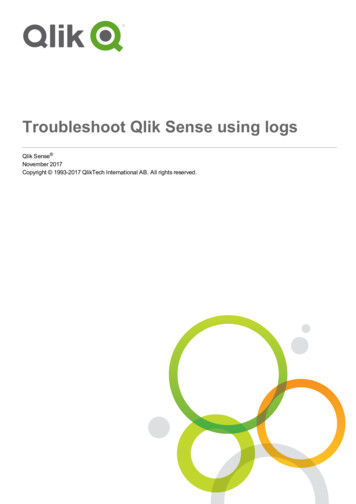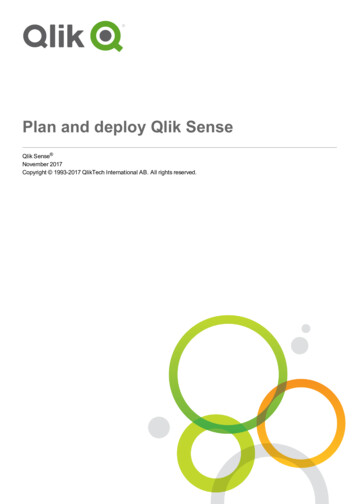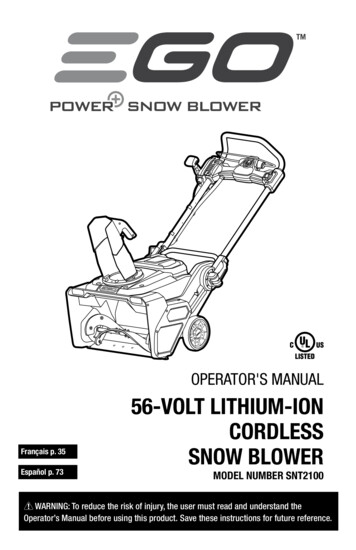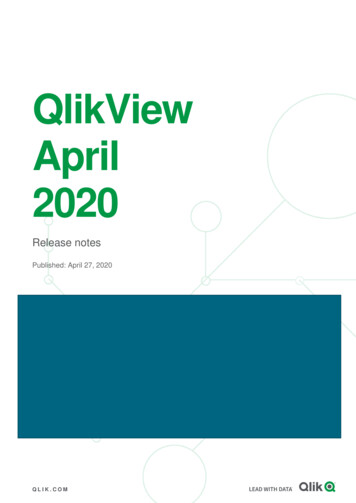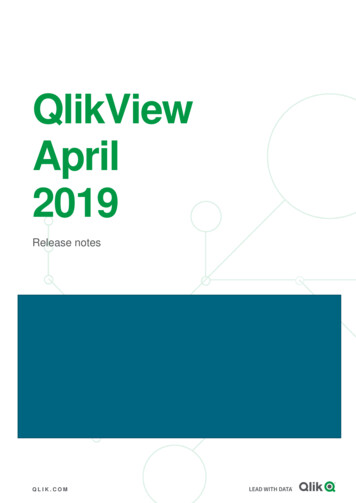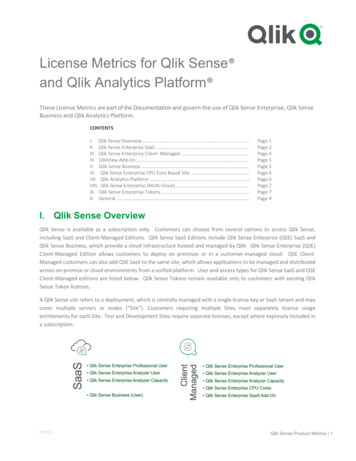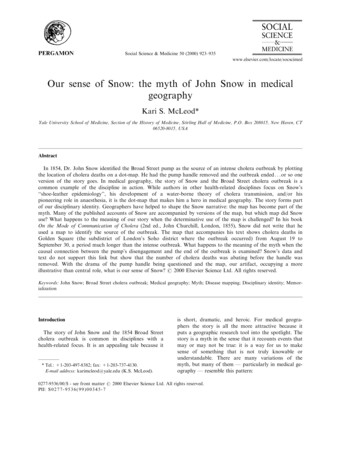
Transcription
Social Science & Medicine 50 (2000) 923 935www.elsevier.com/locate/socscimedOur sense of Snow: the myth of John Snow in medicalgeographyKari S. McLeod*Yale University School of Medicine, Section of the History of Medicine, Stirling Hall of Medicine, P.O. Box 208015, New Haven, CT06520-8015, USAAbstractIn 1854, Dr. John Snow identi ed the Broad Street pump as the source of an intense cholera outbreak by plottingthe location of cholera deaths on a dot-map. He had the pump handle removed and the outbreak ended . . .or so oneversion of the story goes. In medical geography, the story of Snow and the Broad Street cholera outbreak is acommon example of the discipline in action. While authors in other health-related disciplines focus on Snow's shoe-leather epidemiology'', his development of a water-borne theory of cholera transmission, and/or hispioneering role in anaesthesia, it is the dot-map that makes him a hero in medical geography. The story forms partof our disciplinary identity. Geographers have helped to shape the Snow narrative: the map has become part of themyth. Many of the published accounts of Snow are accompanied by versions of the map, but which map did Snowuse? What happens to the meaning of our story when the determinative use of the map is challenged? In his bookOn the Mode of Communication of Cholera (2nd ed., John Churchill, London, 1855), Snow did not write that heused a map to identify the source of the outbreak. The map that accompanies his text shows cholera deaths inGolden Square (the subdistrict of London's Soho district where the outbreak occurred) from August 19 toSeptember 30, a period much longer than the intense outbreak. What happens to the meaning of the myth when thecausal connection between the pump's disengagement and the end of the outbreak is examined? Snow's data andtext do not support this link but show that the number of cholera deaths was abating before the handle wasremoved. With the drama of the pump handle being questioned and the map, our artifact, occupying a moreillustrative than central role, what is our sense of Snow? # 2000 Elsevier Science Ltd. All rights reserved.Keywords: John Snow; Broad Street cholera outbreak; Medical geography; Myth; Disease mapping; Disciplinary identity; MemorializationIntroductionThe story of John Snow and the 1854 Broad Streetcholera outbreak is common in disciplines with ahealth-related focus. It is an appealing tale because it* Tel.: 1-203-497-8382; fax: 1-203-737-4130.E-mail address: karimcleod@yale.edu (K.S. McLeod).is short, dramatic, and heroic. For medical geographers the story is all the more attractive because itputs a geographic research tool into the spotlight. Thestory is a myth in the sense that it recounts events thatmay or may not be true: it is a way for us to makesense of something that is not truly knowable orunderstandable. There are many variations of themyth, but many of them Ð particularly in medical geography Ð resemble this pattern:0277-9536/00/ - see front matter # 2000 Elsevier Science Ltd. All rights reserved.PII: S 0 2 7 7 - 9 5 3 6 ( 9 9 ) 0 0 3 4 5 - 7
924K.S. McLeod / Social Science & Medicine 50 (2000) 923 935Fig. 1. Snow's dot-map of cholera deaths, 1854 cholera outbreak, Golden Square, detail (in Frost, 1936, between pp. 44 45).
K.S. McLeod / Social Science & Medicine 50 (2000) 923 935During a ten-day period at the end of the summerin 1854 there was an intense cholera outbreak inSoho, London during which ve hundred peopledied. Dr. John Snow used a dot-map showing thelocation of cholera deaths to identify the source ofthe outbreak as the Broad Street water pump. Heconvinced the Board of Guardians that the pumpshould be deactivated, they removed the handle,and the number of deaths dropped immediately.(Some versions of the story have Snow removingthe handle himself.) With his work on the BroadStreet outbreak and with the results of his study inthe South London districts that same summer andautumn, Snow proved that cholera was transmittedby contaminated drinking water. His researchhelped to change his contemporaries' theory of disease transmission.John Snow was a physician in the Soho District ofLondon during the mid-nineteenth century who had aninterest in cholera and in anaesthesia. Comprehensivelyestablishing the details of his life is di cult because theonly known personal documents written by Snow arehis Case Books on his experimentation with and administration of anaesthesia, a letter, and a testimonial,all of which are held at the Royal College ofPhysicians (Ellis, 1994). These documents are augmented by the University of British Columbia's Clover/Snow Collection which includes personal correspondence to and about Snow (Thomas, 1992). Shortlyafter Snow's death, his close friend B.W. Richardsonwrote a biographical essay and had it published withSnow's On chloroform and other anaesthetics (Ellis,1994). A second, less informative, and much shorterversion was published in 1887 and reprinted in Frost'sedition of Snow's On the Mode of Communication ofCholera (Frost, 1936). Unfortunately, the accuracy ofRichardson's account is questionable. His Memoir ofSnow was written, with Victorian prolixity, at a timewhen he was only twenty-nine years old and stillmourning the sudden loss of his friend and colleague.Accordingly, careful historical judgement needs to beexercised when assessing some parts'' (Ellis, 1994, p.xi).Despite these di culties, it is possible to construct abrief biography of Snow by supplementingRichardson's essay with research by Ellis (1994, 1991)and Brunskill (1992). John Snow was born in York,England on March 15, 1813, and his father was alabourer. Snow received his preliminary medical training as an apprentice and later attended the HunterianSchool of Medicine in Soho, London. His rst encounter with cholera was in Newcastle during the 1831 1832 epidemic. Snow was involved in the scienti cmedical community, presented papers to medical societies, and published in medical journals, the rst925being the Medical Gazette in 1841. In 1849 he set outhis theory of cholera transmission in a pamphlet called On the mode of communication of cholera'' andexpanded it with more evidence in a book by the samename in 1855. The latter contained the results ofSnow's examination of the water supply in the SouthLondon districts where he found that people living inhouses with water supplied by the Lambeth Companywere 8 12 times less likely to die from cholera during the rst seven weeks of the epidemic, and 5 times lesslikely over the next seven weeks, than people in houseswith water from the Southwark and VauxhallCompany. Lambeth had moved its source upstream onthe Thames in adherence to the 1852 MetropolisWater Act (Luckin, 1986). In this book Snow alsodetailed the results of his investigation of the choleraoutbreak in Golden Square (the subdistrict of Soho inwhich Broad Street is located) and included a map ofthe location of cholera deaths (Fig. 1). The dimensionsof the map are 14 12 by 15 12 inches with a half-inch border and the scale is 30 inches to one mile. Concurrentwith his research on cholera, Snow had a scienti cinterest in anaesthetics. In 1846 he began experimenting with ether and then moved to chloroform. By1850, his reputation as an anaesthetist was well-established, and he was asked to administer chloroform toQueen Victoria during the birth of Prince Arthur if sherequested it. Although his services were not usedduring that con nement, he administered the anaesthetic to her during the births of Prince Leopold in1853 and of Princess Beatrice in 1857. Snow was in theprocess of writing a book on his experiments withanaesthetics when he died on June 16, 1858, probablyof a stroke.Variations of the Snow and Broad Street myth existin public health, epidemiology, history of medicine, geography, and cartography. For the moment, if weaccept as true the version of the story presented at thebeginning of this paper, John Snow is a hero for fourreasons. The rst three of are not necessarily con nedto a disciplinary context while the last is more characteristic of geography. First, John Snow showed how adisease is transmitted Ð clearly something laudable inscience and medicine. Through his investigations hedemonstrated that cholera was not transmitted inmiasmata (bad air), the dominant scienti c theory atthe time, but in contaminated drinking water andthrough human contact. Second, his ideas a ectedpublic health and health policy decisions, at least atthe local level. Snow convinced someone, or somegroup, to remove the handle from the Broad Streetpump. Third, he provided de nitive proof of a hypothesis, and as a result of the power of his evidence andhis argument he changed scienti c opinion to fact.Finally, John Snow used the quintessential geographicartifact as a spatial-analysis device to show that the
926K.S. McLeod / Social Science & Medicine 50 (2000) 923 935pump was the source of the local epidemic. The mapdemonstrated the relative space of death-eventsarranged around a locationally xed point. It also con rmed his theory that cholera was transmitted throughpolluted drinking water.A timely re-examinationFor geographers in general and medical geographersand cartographers speci cally, the map is of centralimportance in the story. However, there are many variations of the map in the geography literature, and it isnot clear which map Snow would have used to identifythe source of the outbreak. This ambiguity leads toquestions about whether Snow drew the map (or hadthe data compiled and displayed on the map by someone else) to determine the source of the outbreak or asan illustration of his argument. The meaning ofSnow's map for medical geography illustrates thepower of cartography. Maps are not just analyticaltools. They are visual arguments that contain and convey political statements, meaning, and power (Harley,1989; Monmonier, 1991; Muehrcke, 1996; Tufte, 1997).Thrower describes Snow's cholera dot-map as achieving the highest use of cartography: to nd out bymapping that which cannot be discovered by othermeans or, at least, not with as much precision''(Thrower, 1996, p. 150). May wrote that many secretsof nature'' would have been revealed had humansaccurately mapped disease throughout history (May,1958, p. 25). However, despite mapping's meaningfulplace in medical geography, Pyle notes that it is alsocontroversial (1979). Can disease maps show causation? Do they prove anything? Do medical cartographers actually state that causation and proof exist intheir maps, or do the map interpreters project thoseexpectations?Recent questions about the presentation of the storyof Broad Street outbreak in the medical geography literature (McLeod 1998a,b; Rip et al., 1998) also t intothe debate on the nature of the discipline (see Bennett,1991; Mayer, 1992; Kearns and Joseph, 1993; Dornand Laws, 1994; Kearns, 1994; Mayer and Meade,1994; Del Casino and Dorn, 1998 for some examples).Some authors have argued that the traditional concerns of medical geography Ð the geographic study ofdisease and of accessibility, utilization, and provisionof health care Ð are rooted in spatial theory, and assuch miss the complexity of human experiences withhealth, illness and healing by hiding behind the simplicity of quantitative explanation. Authors have also critiqued the biomedical model of disease as the basis forour understanding both de nitions and processes ofdisease and methods and expectations of treatment forfour reasons. It presents disease as a deviation from ade ned normal', proposes that each disease has asingle cause with a distinct pathogen agent, microorganism or disease vector'' (Curtis and Taket, 1996,p. 27), assumes that the manifestations of diseases aregeneric in all individuals, and portrays science andmedicine as objective, rational, and neutral. Alongsidethese criticisms have come calls for alternative understandings of experiences of illness and wellnessinformed by: social theories (from Marxism andhumanism to postmodernism and poststructuralism),space and place as de ned and mediated throughhuman activity and the construction of meaning(rather than as a geometric absolute measurement),and views of illness as socially constructed (rather thanbiomedically de ned). Proponents of these changesalso call for the adoption of qualitative and textualanalysis methodologies, either in addition to or exclusive of quantitative methods.This is an appropriate time to re-examine JohnSnow Ð medical geography's hero Ð because duringthis latest period of looking forward to what the discipline should be about, we should also look at what webelieve the discipline is and has been. Determininghow Snow used his dot-map of cholera deaths to studythe outbreak speaks to how we as medical geographersview the importance, place, and meaning of mappingin the study of disease. By re-examining the details ofthe story, this paper challenges what we value in theBroad Street myth: that Snow used a dot-map todetermine the source of the outbreak, successfullyargued for public action to disengage that source, andstopped the outbreak. This paper is divided into foursections. The rst will show how disciplines other thangeography present Snow in ways that represent theirdisciplinary identities. The second will examine medicalgeography's focus on the map in the story of BroadStreet. The myth forms part of the identity of our discipline Ð whether we call it medical geography, post'medical geography, the geography of health and healthcare, or health geography (Barrett, 1992; Kearns,1996). The third section will draw on archival evidencecollected in London, England in the winter of 1997 toretell some of the details of the Snow myth. The process of challenging the story will raise the question, What is our sense of Snow?'' The nal section willpresent some of the many themes opened up by amore critical and complex understanding of Snow andthe 1854 Broad Street cholera outbreak.Snow from other disciplinesAny investigation of the portrayal of John Snow inthe medical geography literature inevitably leads toreferences in epidemiology, public health and the history of medicine. These literatures also contain mythi-
K.S. McLeod / Social Science & Medicine 50 (2000) 923 935cal representations of Snow and the Broad Street outbreak; however, a few authors have revisited the mythand both related the details of Snow's life in a morehistorically accurate way and/or examined the meaningof the Snow myth (Pelling, 1978; Vandenbrouke et al.,1991; Ellis, 1994; Lock, 1994; Winkelstein, 1995). Toexamine how Snow is portrayed in di erent disciplines,I conducted a broad survey of the literature by collecting Snow anecdotes and references from textbooks,books, papers, and the Internet, and organized themwithin three disciplinary contexts: public health andepidemiology, history of medicine, and medical geography. I collected the literature in stages, starting withsearches of the library databases at CarletonUniversity and the University of Ottawa includingtheir Current Contents database for journal articlespublished during the last ve years. I then used thereferences cited in these sources to expand the survey.These searches were augmented by Snow referencessent to me by people, mostly professors, interested inmy research. The earliest references found were fromthe mid-1930s, which is consistent with the results ofsimilar work done by Vandenbrouke et al. (1991).Categorizing each source under one of three disciplinary headings was not always straightforward, especiallyfor references on the history of health-related disciplines in practical textbooks, but I classi ed each onein terms of the context of the source document.This content analysis revealed that Snow's reputation is well-established in public health, epidemiology, and history of medicine, but in ways that aresigni cantly di erent from his reputation in medicalgeography as an early medical cartographer. The disciplinary portraits presented in this paper are necessarilybrief summaries of the multiple versions of the Snowmyth I uncovered in the literature, which is understandably problematic for the task of unpacking representations of myth. Nevertheless, the purpose here isto introduce the ways in which authors have createdSnow as an heroic gure and to provide insight intohow the Broad Street story helps to de ne disciplinaryidentities. In this section I will treat epidemiology andpublic health together, recognizing that their histories,intents, literatures, and functions are not interchangeable. The history of medicine is a catch-all phrase todescribe literatures from the history of disease, the history of medicine, and other historical literatures (suchas social histories of Victorian England) that mentionJohn Snow.Epidemiology, public health, and engineering forpublic health present Dr. John Snow as a pioneer epidemiologist. He is, after all, the father of shoe-leatherepidemiology'' Ð a title originating from his house-tohouse survey in the South London districts (see Frost,1936; Holland et al., 1978; Barker and Rose, 1979;Hennekens and Buring, 1987; Last, 1987; Levine and927Lilienfeld, 1987; Vandenbrouke et al., 1991; Dadswell,1992; Stolley and Lasky, 1995; Winkelstein, 1995 forsome of the many accounts). The literature not onlydescribes Snow's role in the Broad Street cholera outbreak, but also recounts his development of a waterborne theory of cholera transmission and his study ofthe water supply in the South London districts. In thisinvestigation he used data from the RegistrarGeneral's o ce, a house-to-house inquiry, and achemical test of water purity, and showed that housessupplied by the Southwark and Vauxhall water company had a higher cholera mortality rate than thosedwellings supplied by the Lambeth company(Hennekens and Buring, 1987; Levine and Lilienfeld,1987; Stolley and Lasky, 1995). Snow is a revered gure in the disciplinary history because he showedthat cholera was transmitted by drinking water polluted by sewage. His ndings led to the elimination ofcholera by the provision of pure water supplies manydecades before the isolation of the causal organism''(Farmer et al., 1996, p. 13).These disciplines do not focus on the dot-map intheir stories of the Broad Street cholera outbreak,although Stolley and Lasky provide detail of a mapwith a side-bar that reads: John Snow mapped theoccurrence of cholera cases in these streets of London. . .He also marked the positions of the local waterpumps. Snow deduced that water from the BroadStreet pump was the source of cholera'' (1995, p. 35).Instead of the map, the discipline commemorates Snowfor his logic in developing his water-borne theory ofcholera transmission, his methodology, and his successin e ecting a public health action that saved manylives. According to Calkins (1987) and Winkelstein(1995), the Board of Guardians of the parish of St.James removed the handle from the Broad Streetpump on the advice of Snow. A number of otherauthors describe Snow's failure to convince the Boardand his removal of the handle himself (Charles, 1961;Sterritt and Lester, 1988; Acheson, 1992; Dadswell,1992; Godlee and Walker, 1992).The nature, purpose and intent of epidemiology,public health, and engineering for public health areevident in the representations of Snow in the literature.Epidemiology is the scienti c study of disease origin,pathology, transmission patterns, and preventionmeasures at a population scale. As the basic disciplineof public health'' (Holland, 1977, p. 12), the knowledgeit produces is translated into policies for promotinghealth in a population. One of the roles of engineeringfor public health is the provision of safe drinkingwater for populations. Snow and his work on choleraprovide a focal point that illustrates disciplinary identity for each of these elds of study.Snow is also a character in the history of medicine.There is an impressive breadth of information on
928K.S. McLeod / Social Science & Medicine 50 (2000) 923 935Snow in the literature, but he does not occupy as prominent or speci c a place in the discipline as in medical geography, public health, or epidemiology. Thereare two possible reasons for this. First, Snow's contribution to medicine has been less signi cant than thework of the Hippocratic tradition, Galen, Harvey,Jenner, Lister, Koch and Pasteur. Second, Snow isportrayed as a pioneer in both epidemiology andanaesthesia (see Scott, 1934; Rosenberg, 1962, 1992;Pelling, 1978; Smith, 1979b; Magner, 1992; Bynum,1994; Ellis, 1994; Lock, 1994 for some of theaccounts). Depending on their purpose, authors candiscuss Snow's theory of cholera transmission in itshistorical context (Smith, 1979b; Rosenberg, 1992;Lock, 1994) including his work in Broad Street and inthe South London districts. They can describe his earlywork with ether and chloroform as anaesthetics culminating in his administering the latter as an analgesic toQueen Victoria during the births of her last two children (Magner, 1992; Ellis, 1994). Or, they can combineboth representations.Two sources in the history of medicine literaturecontain reproductions of Snow's dot-map (Longmate,1966, p. 205; Bynum, 1994, p. 80), but it is only one ofthree explanations given for how he identi ed thesource of the outbreak. Lock (1994) describes howSnow used both death records from the GeneralRegister O ce [sic ] and his own personal investigationduring the beginning of the outbreak to determine thatthe 89 recorded deaths in the parish were located nearthe Broad Street pump and that 69 of these peoplewere known to have drunk water from the pump.Fig. 2. Gilbert's recreation of Snow's dot-map (Gilbert, 1958, p. 174).
K.S. McLeod / Social Science & Medicine 50 (2000) 923 935Three authors (Chave, 1958; Morris, 1976; Lock, 1994)explain that Snow's investigations were only possiblewith the help of Henry Whitehead, a local curate. Inthe literature, much of the discussion on Snow, his theory, and his 1854 investigations concerns their impacton Snow's contemporaries, on the predominant miasmatic theory of disease, and on public health policy(see Luckin, 1986; Riley, 1987; McKeown, 1988;Kudlick, 1996 as well as some of the aforementionedsources).Snow is remembered in the history of medicine literature for his dual role as a pioneer in epidemiologyand anaesthesia. Of all the literature surveyed for thisproject, the history of medicine literature provides themost detailed biographical information on Snow.These authors are the most consistent in placingSnow's work in its historical context and for examiningits contemporary e ects, which is not to imply thatsome of the details in these disciplinary accounts arenot questionable. Instead, I am suggesting that a comparison of the disciplinary accounts of Snow and theBroad Street outbreak with the archival evidence doesnot challenge Snow's place in the disciplinary identityof the history of medicine in the same way that it doesin the disciplinary identities of epidemiology and public health or medical geography.Medical geography and the mapMonmonier recently wrote, When asked about disease maps, most epidemiologists and geographersthink of John Snow's 1854 map of cholera deaths andthe Broad Street pump'' (Monmonier, 1997, p. 263).The story of Snow and Broad Street is popular in themedical geography literature and can also be found ingeneral geography and cartography literature (seeMay, 1958; Gould, 1985; Adesina, 1991; Thomas,1992; Curtis and Taket, 1996, plus the map sourcesreferred to below for some of the many descriptions).Many of these accounts follow the format of the storypresented at the beginning of this paper, with Snowusing the map to determine the source of the outbreak.Medical geography Ð and geography and cartographymore generally Ð memorializes Snow's use of a dotmap to identify the source of the Broad Street choleraoutbreak by reproducing the map in the literature. Heis known as a pioneer medical cartographer who produced a very signi cant document in the history ofmedical geography'' (Gilbert, 1958, p. 175).Reproductions and re-creations of the map havebeen printed in journal articles (Gilbert, 1958; Smith,1993), books and textbooks (Stamp, 1964a,b; de Blij,1977, 1993; Jones and Eyles, 1977; Howe, 1972; Smith,1979a; Eyles and Woods, 1983; Cli and Haggett,1988; Learmonth, 1988; Meade et al., 1988; Jones,9291990; Monmonier, 1991), and on the Internet (see Just Another Medical Geography Page'' at http://members.xoom.com/mgdigest/medical geography.html ).Snow's map is also a common example in geographyand cartography courses. However, a close look at themaps begs the question, Which map is Snow's map?'',because their appearance and content are inconsistent(Tufte, 1997; McLeod, 1998a).Stylistic and substantive di erences in the reproductions (or re-creations) of Snow's map become evidentwhen we compare two versions printed in the geography literature. I have chosen to use an early version ofthe map (Gilbert, 1958, p. 174 Ð Fig. 2) and a morerecent one (Monmonier, 1991, p. 142 Ð Fig. 3) as illustrations of these di erences and as contrasts toSnow's original map (Fig. 1). Neither reproductioncontains a north arrow, nor does the original for thatmatter. Both maps symbolize the location of choleradeaths with dots, but Gilbert notes that deaths weremarked with black rectangles on Snow's original map.He does not explain the cartographic change. Gilbert'smap shows the locations of the pumps with small Xs;whereas, Monmonier's represents them with large darkOs. More discrepancies become evident upon closerexamination. Gilbert includes a delimited study-area, abar scale, and several street names, elements omittedby Monmonier who uses only a labeled arrow to identify the Broad Street pump. The streets on Gilbert'smap are open-ended and have di erent widths.Monmonier's streets are closed at the ends and aremore uniform in width with smoother lines (see thearea on both maps near the pump towards the bottomof Dean Street for comparison). It seems likely thatFig. 3. Monmonier's recreation(Monmonier, 1991, p. 142).ofSnow'sdot-map
930K.S. McLeod / Social Science & Medicine 50 (2000) 923 935streets have been omitted from both maps becausetheir respective patterns of dots between Broad Streetand Brewer Street suggest the existence of streets. Asthe Snow map has been reproduced and re-created, thecartography symbolizing the location of deaths hasbecome messier (Tufte, 1997; McLeod, 1998a), resulting in concrete di erences. For example, at a residencenear the pump (below and to the left) there are sixteendots on Gilbert's map and twenty on Monmonier's.There are eighteen at this location on Snow's map.Finally, Gilbert cites Snow's map as his source anddocuments the di erences between his re-creation andthe original; Monmonier does not provide a source forhis version.Although the story of the role of Snow's map in theBroad Street cholera outbreak is common in the literature, it has not been uncritically accepted by allauthors, nor is it the only aspect of Snow's choleraresearch to be examined. Learmonth questions whetherSnow used the map as an actual tool of research'' tolocate the source of the outbreak (1988, p. 148). Jonesand Moon (1987) do not mention Broad Street in theirportrayal of Snow. Instead, they use his study of thewater supply in the South London districts as anexample of a natural experiment.Taking a close look at the re-creations and reproductions of the Snow map challenges the prominentplace of the dot-map in medical geography's myth ofthe Broad Street cholera outbreak. Questions aboutthe role of the map in Snow's investigation arise fromthe variations between the maps. Snow's map is ouricon Ð our cultural artifact, but we have not presenteda consistent image of it. The myth of John Snow inthe geographic literature is as much a myth of the mapas it is of anything else, and the story helps to de newhat some medical geographers want the discipline tobe about: one of the contributing sciences to the studyof disease.Part of the story retoldThe process of critically examining the cartographicrepresentations of Snow's map in the literature provokes questions regarding the details of the BroadStreet story and the accuracy of Snow's reputationwithin various disciplines. In this section I will usesources collected in London, England in 1997 to challenge the story presented at the beginning of thispaper. I will address only two details of the myth anddisregard the others and their implications for how disciplines represent Snow. First, did Snow use a dot-mapto determine that the Broad Street pump was thesource of the cholera outbreak? Second, what e ectdid the removal of the handle have? I will not discussthe fact that there is no evidence to suggest thatSnow's work on cholera directly led to the provisionof safe drinking water in London or to support theassertion that his evidence and argument immediatelychanged the predominant theory of disease transmission.Snow produced his Broad Street ndings in twopublications: the second edition of his work On theMode of Communication of Cholera (Snow, 1855a1)and the Report on the Cholera Outbreak in the Parishof St. James's, Westminster, During the Autumn of1854 (Snow, 1855b, pp. 97 120). His own descriptionprovides the most e ective source for examining howhe decided that the Broad Street pump was the focusof the local outbreak (Snow, 1855a, pp. 38 40). Hewrites that he suspected that contaminated waterfrom the pump was spreading cholera in the area,but that samples did not reveal the water to be particularly dirty. After it sat on his counter for a coupleof days however, he noticed white akes had formedin the water. He then obtained a list of deaths in thearea from the Registrar-General's O ce for the weekending September 2 and determined the addresses ofthe 83 choler
Richardson’s account is questionable. ‘‘His Memoir of Snow was written, with Victorian prolixity, at a time when he was only twenty-nine years old and still mourning the sudden loss of his friend and colleague. Accordingly, careful historical judgement needs to be ex


